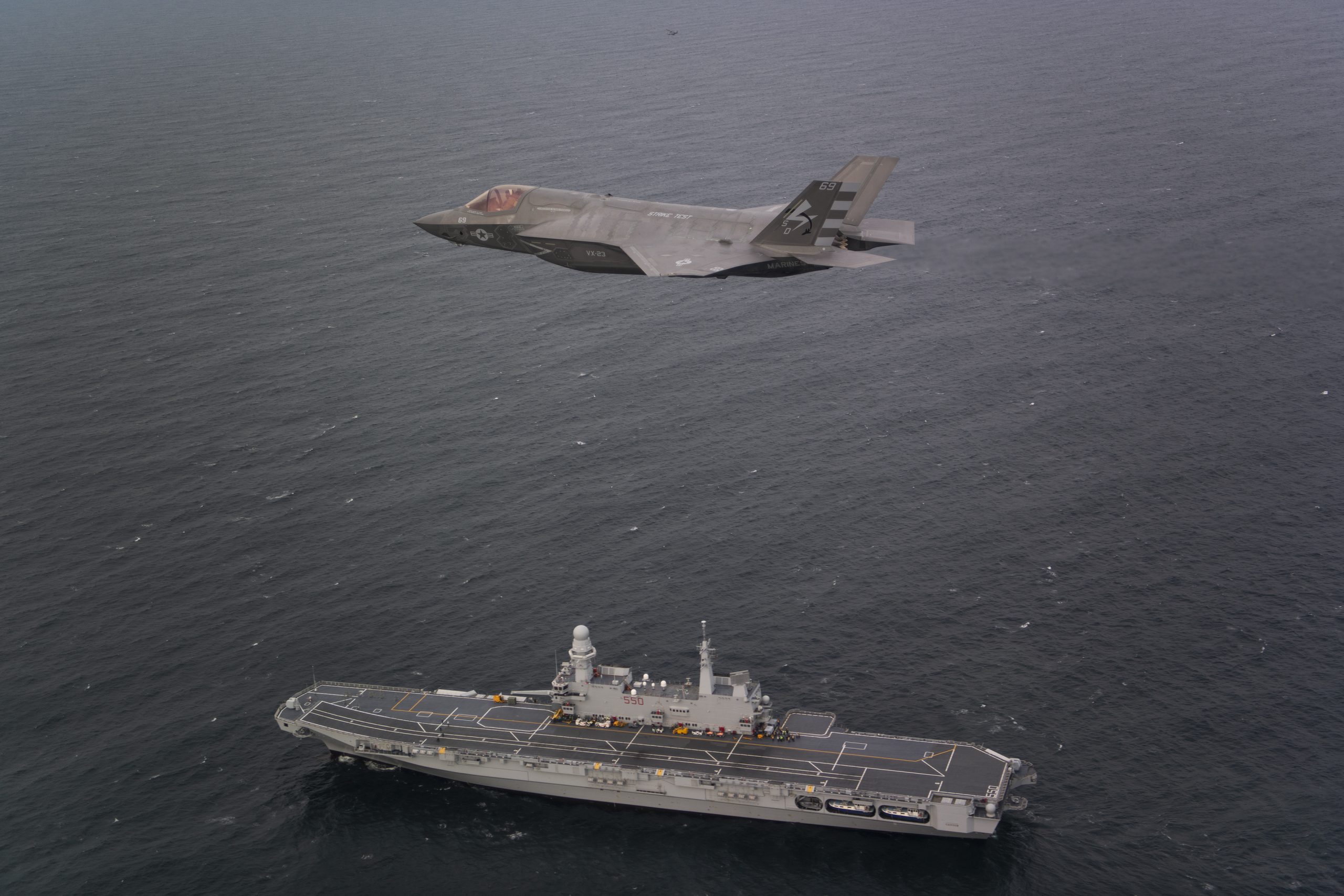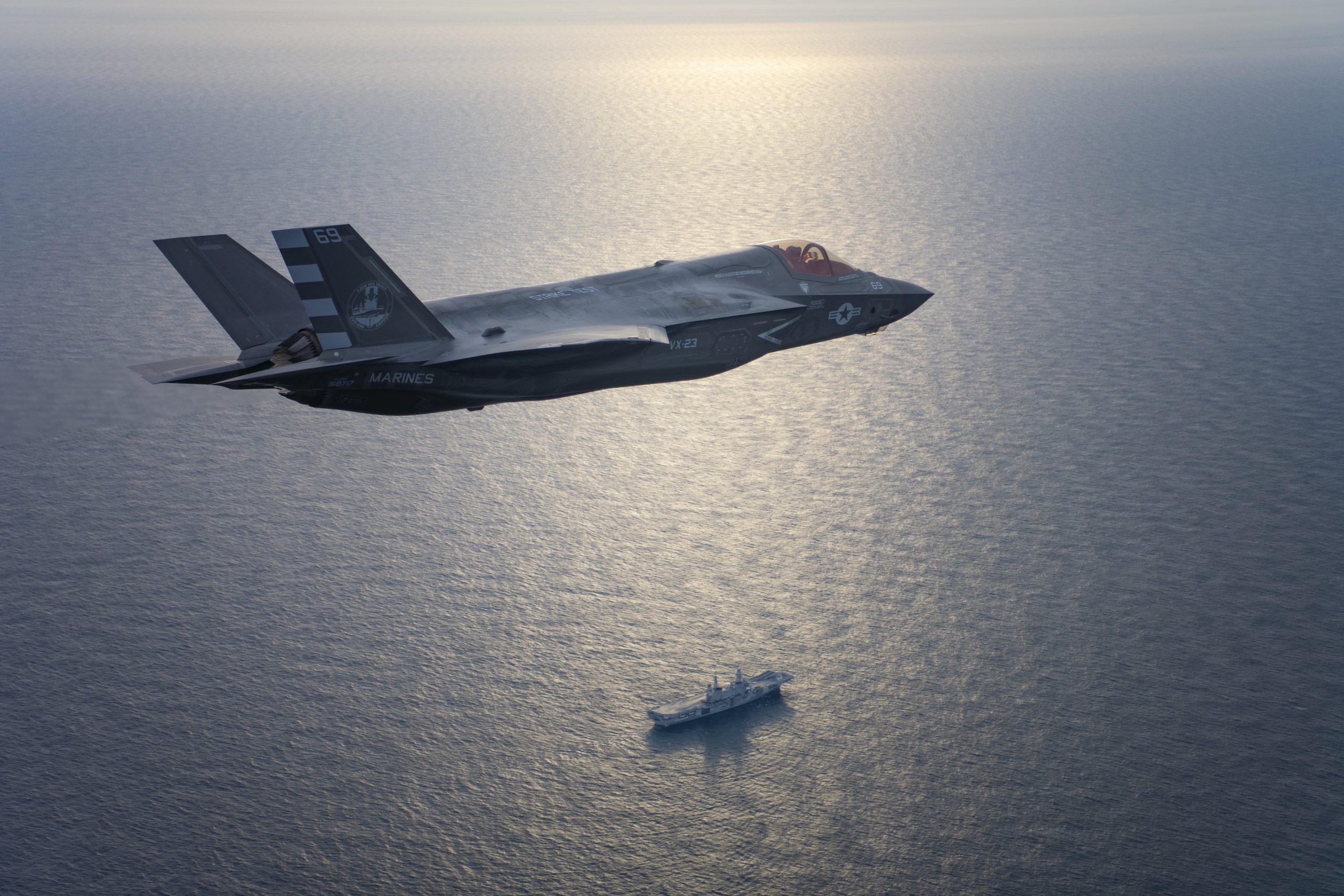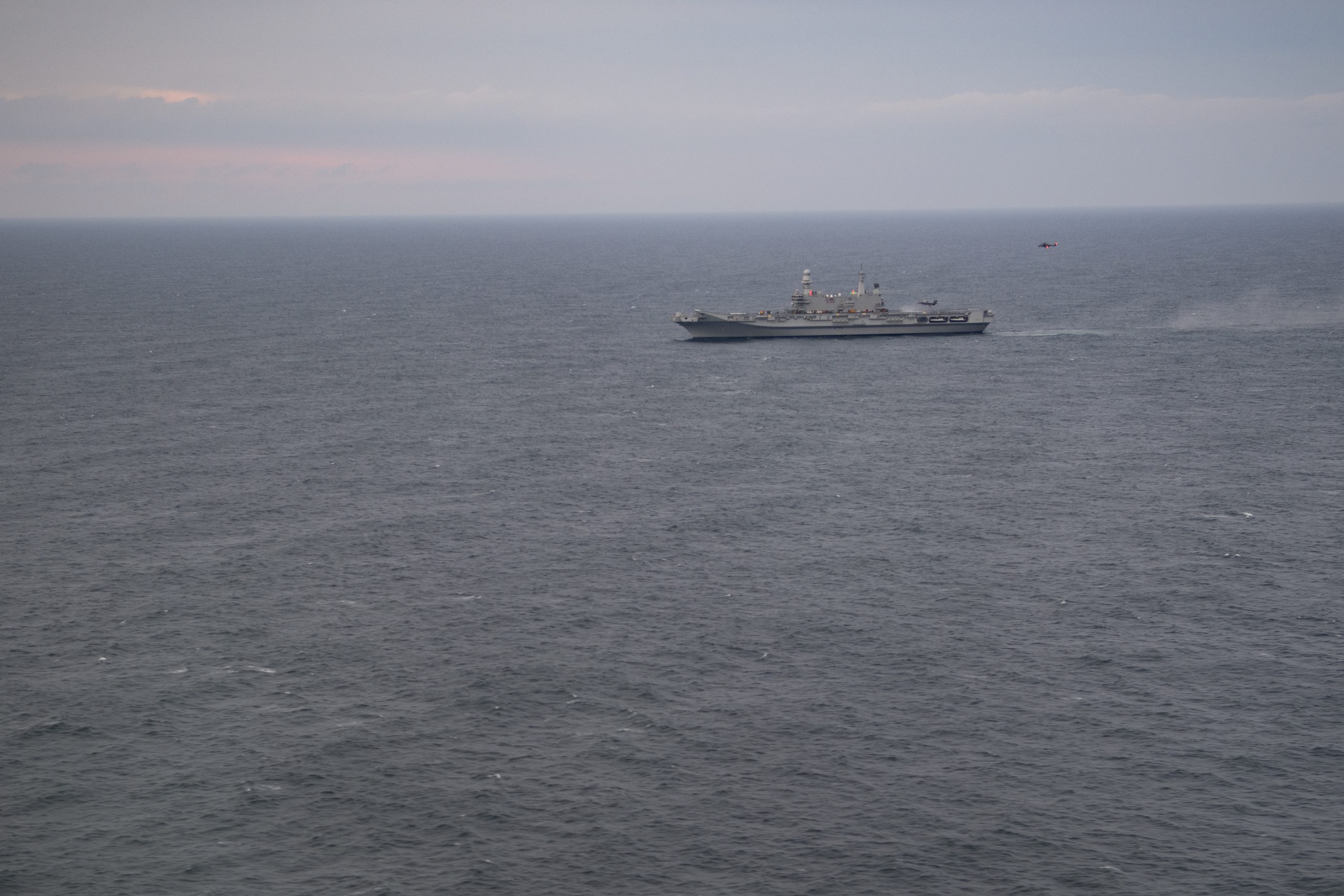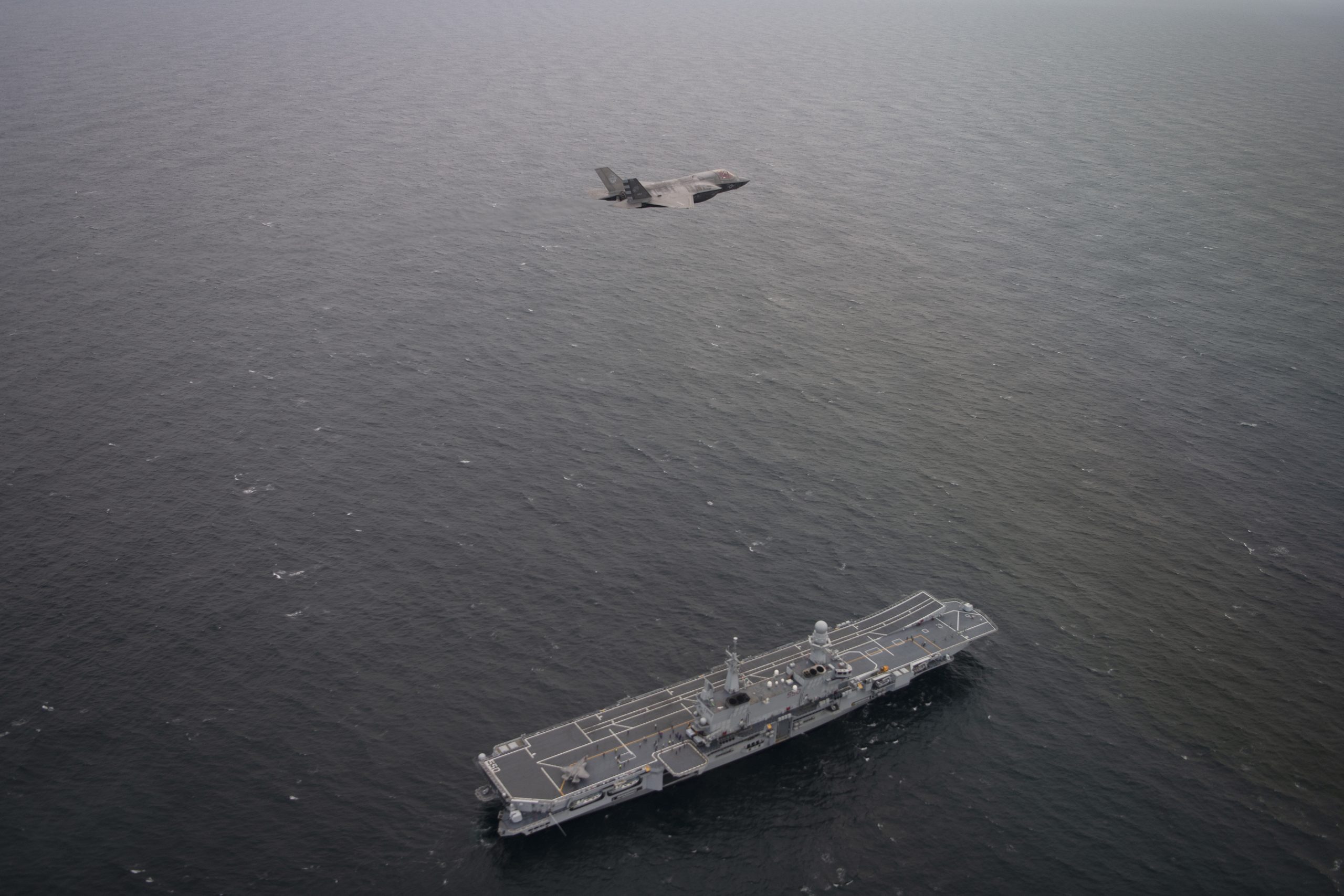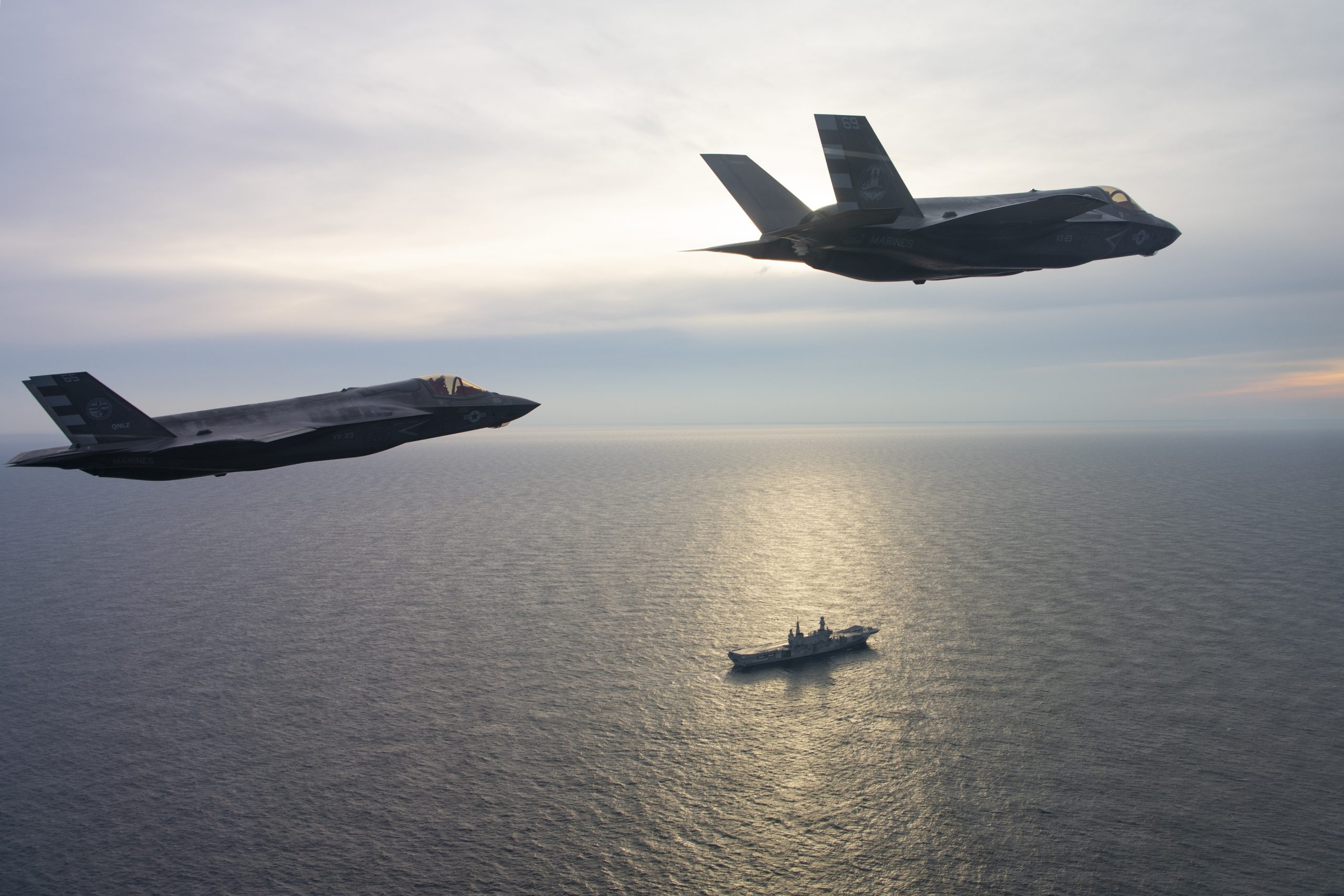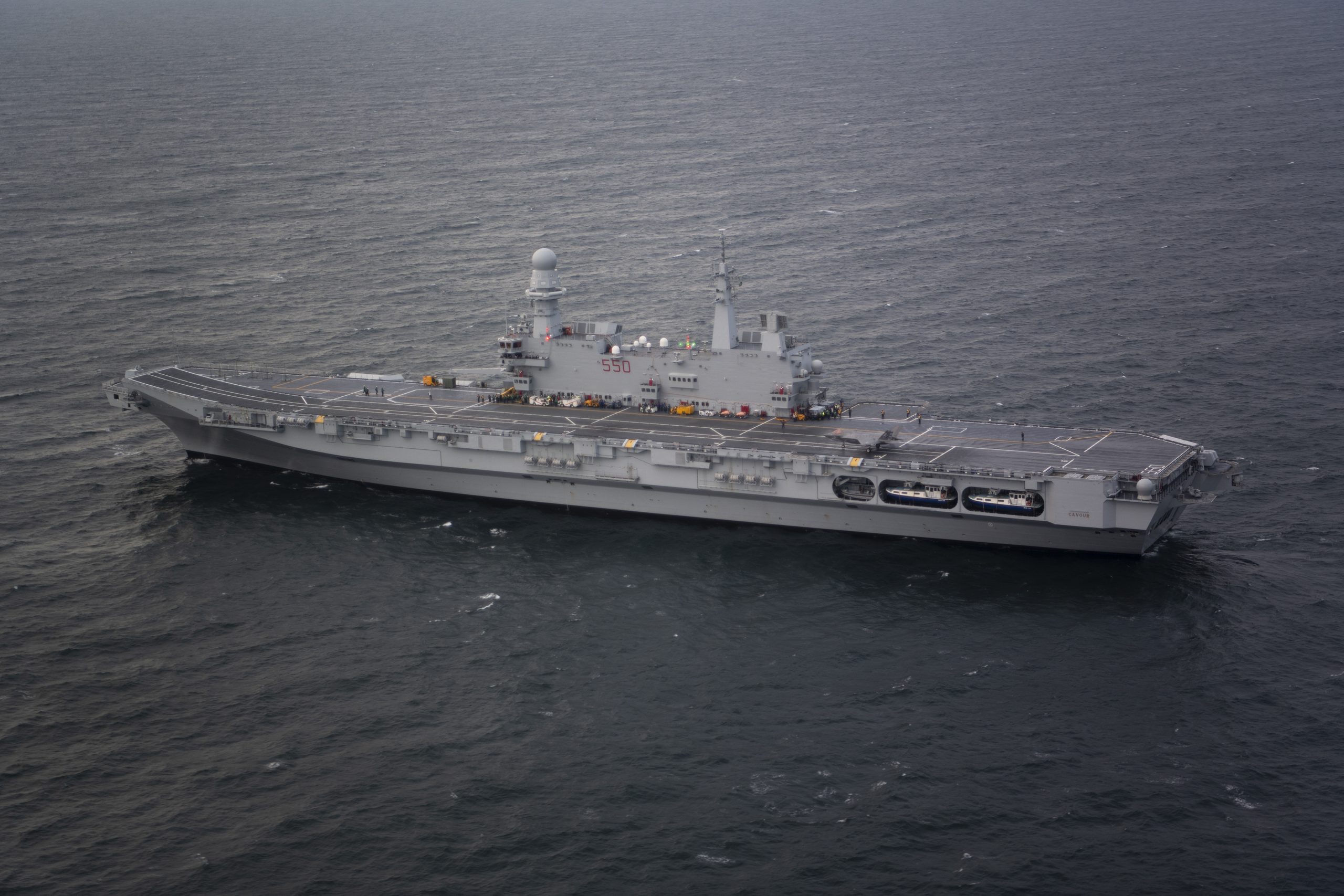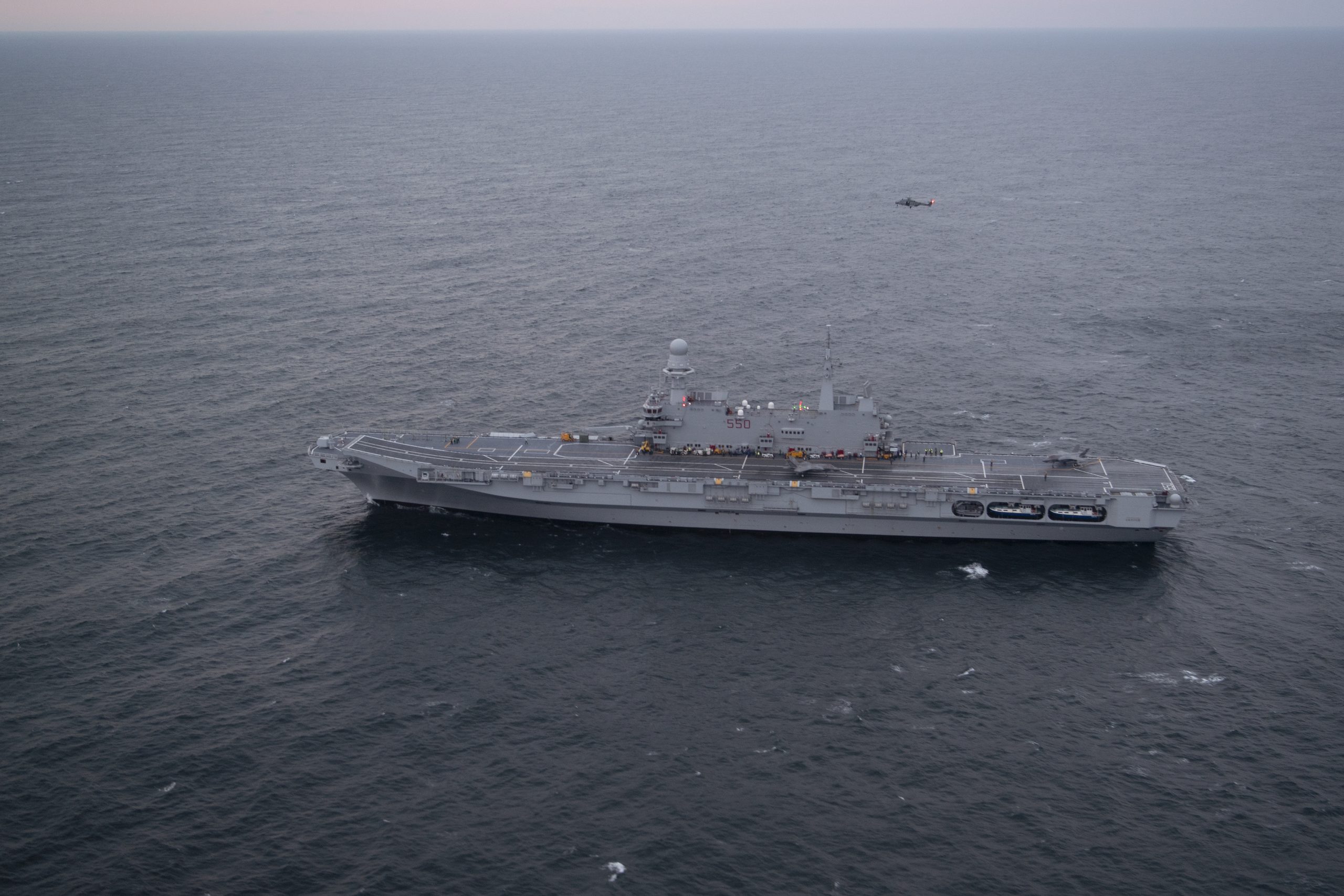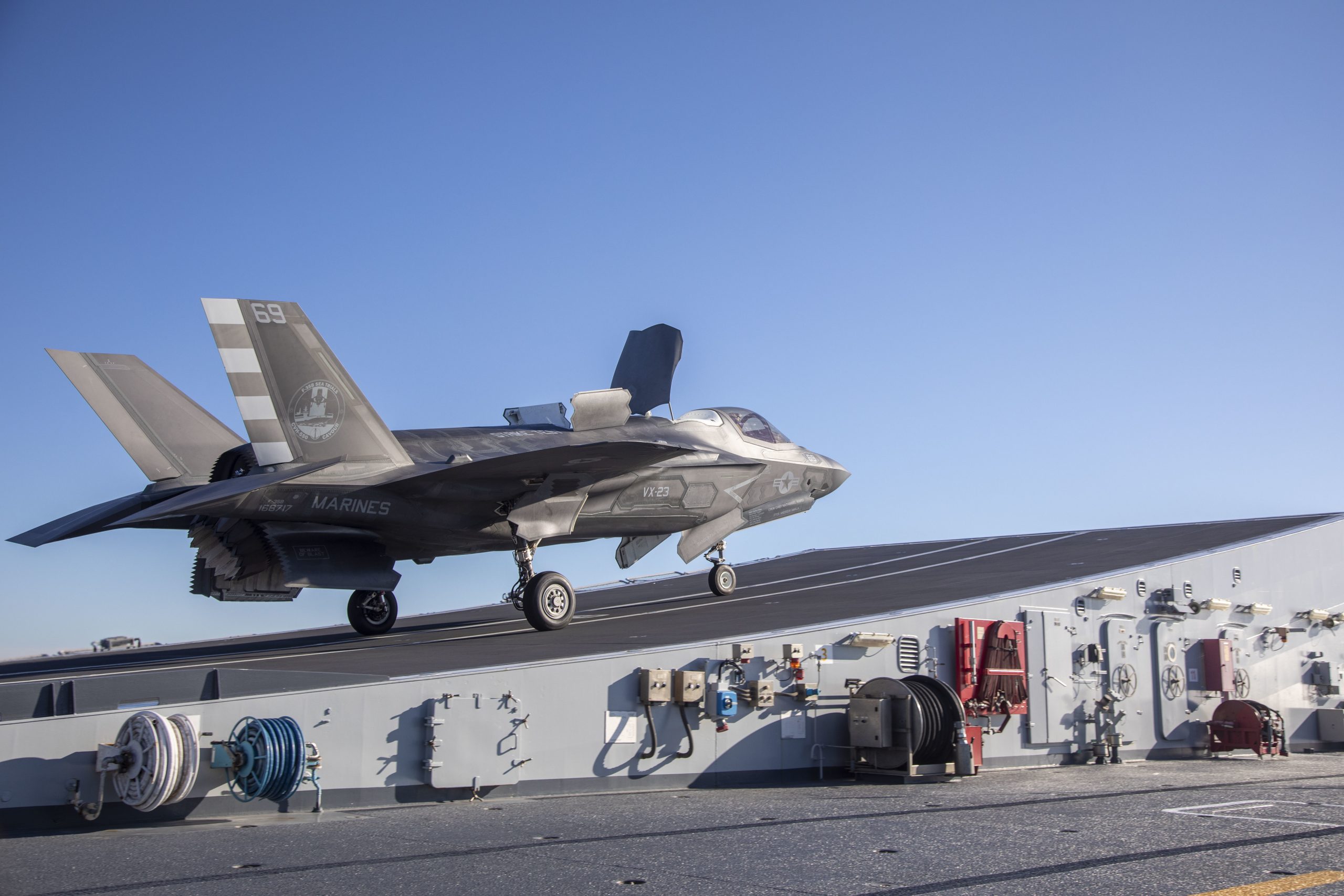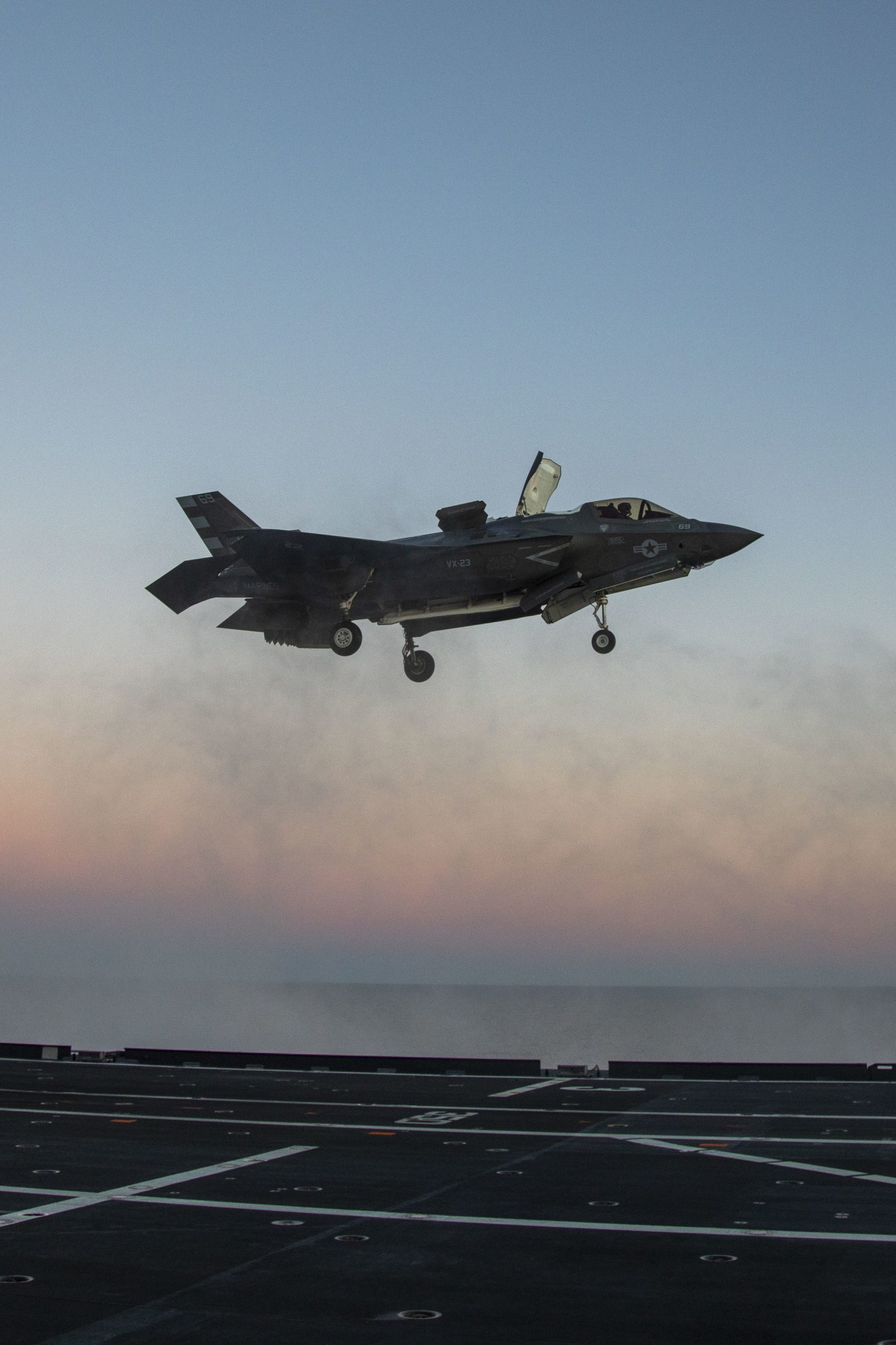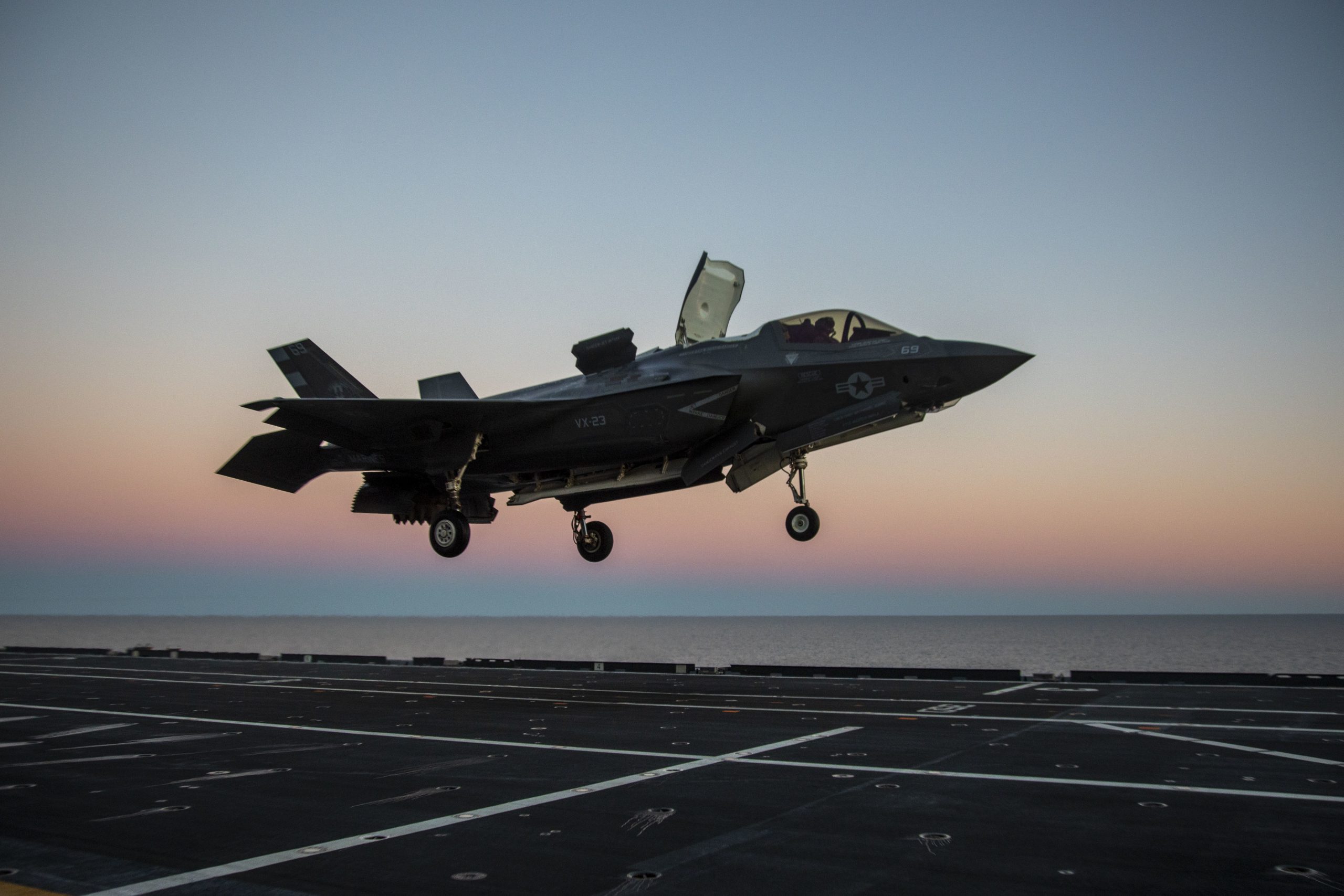The Italian aircraft carrier the ITS Cavour is operating off of the Virginia Coast in order to integrate with the F-35Bs which it will operate for the next several years.
The coming of the ITS Cavour is an interesting case study in terms of Italian policies, USMC-US Navy integration, the reshaping of North Atlantic defense and a host of other issues.
We will deal with the ITS Cavour as a case study in a separate piece.
What we will highlight here are the stories released by the U.S. Navy to date with the coming of the ITS Cavour first to Norfolk and then operating off of the waters of the East Coast.
We learned from a January 27, 2021, photo release that the ITS F-35B team was already at Pax River to prepare for the arrival of their ship coming the next month to Norfolk.
Test Pilot Marine Maj. Dylan “Bilbo” Nicholas, with the Air Test and Evaluation Squadron TWO THREE (VX-23), conducts day-into-night training in an F-35B short takeoff and vertical landing (STOVL) variant aircraft from the F-35 Patuxent River Integrated Test Force (ITF) at Naval Air Station Patuxent River, Md., Wednesday, Jan. 27.
These workup testing and training flights are integral to preparing pilots for the ITF test team’s detachment to the Italian Navy aircraft carrier Cavour scheduled between February and March.
During carrier-based flight test, also known as sea trials, ITF members with the engineering and test pilot expertise and experience will gather data that will verify compatibility between the 5th generation fighter aircraft and the Italian naval fleet’s flagship.
This information will contribute to certifying the ship for the Italian Navy’s operation of its own F-35Bs, adding a key weapon system to the carrier and increasing its expeditionary capability.
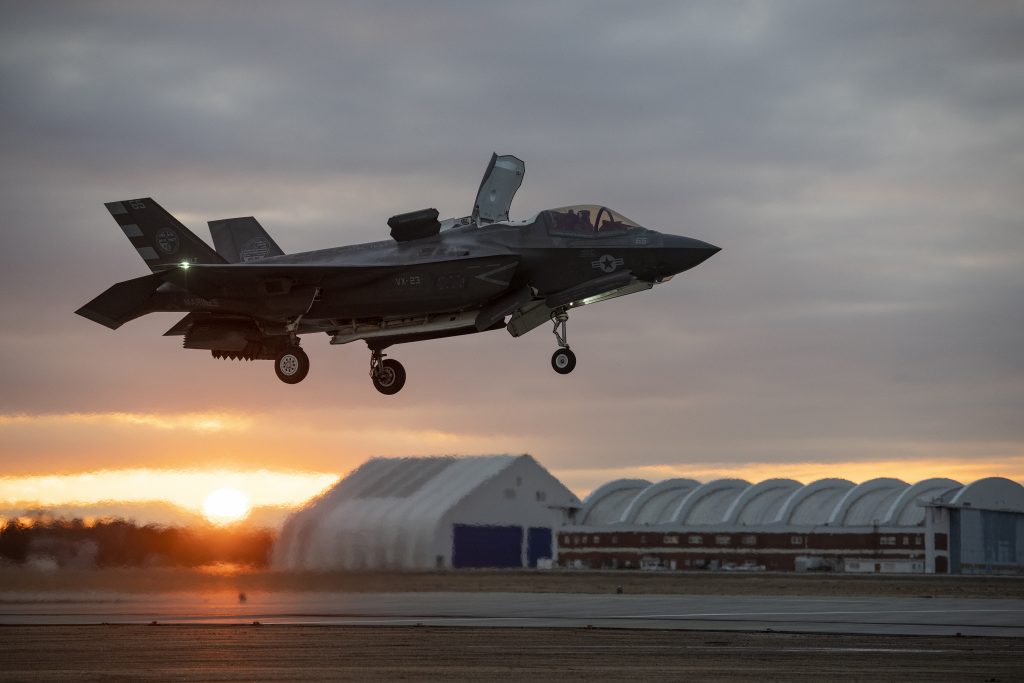
In a February 13, 2021 story we learn that the ITS Cavour arrived at Naval Station Norfolk.
While in the Western Atlantic, Cavour will be embarked by an F-35 Joint Program Office (JPO) test team to conduct sea trials, a series of tests and functional activities to create a safe flight operating envelope for the short takeoff and vertical landing (STOVL) variant of the 5th generation aircraft aboard the recently upgraded ship.
This carrier-based flight test and other actions with U.S. 2nd Fleet ships and aircraft improve interoperability and strengthen the relationship between two NATO Allies.
“Operating in the Western Atlantic with our NATO allies presents a mutually beneficial opportunity to enhance both of our Navies’ capabilities,” said Vice Adm. Andrew Lewis, Commander of U.S. 2nd Fleet. “Supporting our Italian allies in certification of their aircraft carrier increases our collective experience in safety and combat abilities. We are stronger together.”
While crossing the Atlantic from Italy, ITS Cavour was met by the Arleigh-Burke class guided-missile destroyer USS Stout (DDG 55) and conducted a three-day interoperability exercise with support from Carrier Air Wing (CVW) 7 and Patrol and Reconnaissance Wing (CPRW) 11. Specific events included integrated ship maneuvering, low-slow-flyer detect-to-engage, anti-surface warfare serials with P-8 participation, air defense/air intercept control event with F/A-18 participation, and C5I interoperability events in the Western Atlantic 10-12 Feb.
In a February 21, 2021 story, we learn that the F-35 team working with ITS Cavour will be able to test the logistics enterprise.
A container marked “PAX Flight Deck Gear CAVOUR DET 2021,” tri-wall boxes for the work centers, shipping containers with massive aircraft air & power units, engine trailers, and other aircraft support equipment (SE) were craned aboard, forklifted through the hangar, and positioned aboard Italian aircraft carrier ITS Cavour moored here over the last week of February.
The Italian navy flagship arrived here Feb. 13, 2021 as part of the Italian navy’s Ready for Operations (RFO) campaign to certify the recently upgraded ship’s compatibility with F-35 Lighting II aircraft and prepare to operate the 5th generation fighter as its key weapons system.
Before the arrival of the specially instrumented U.S. test jets that will be used to develop and expand a flight envelope, the special tools, parts (those required plus those possibly needed), and support equipment must be aboard and in its place. This undertaking is all in a (couple of) days’ work for F-35 Patuxent River Integrated Test Force (PAX ITF) logistics lead and his team, as well as the many who support the mission.
That effort comprises ensuring that “part of PAX” gets aboard the ship before two F-35B short takeoff and vertical landing (STOVL) test jets ferry from the southern Maryland naval air station to the aircraft carrier after it sets sail, said the PAX ITF logistics team supervisor.
“I love the challenge,” said F-35 PAX ITF logistics supervisor Pat DeLeon, in between a worker asking how to get a pair of leather gloves and another querying where to find the wire cutters. A day earlier he was driving a forklift on the flight deck, and tomorrow, … well, he’ll be wherever he’s needed.
For the moment, in the relative quiet before “Lightning II strikes,” there is a hum of languages, foreign and familiar, in the hangar. A look around makes it clear this is a coalition mission: “For Entry Contact … ” and “NO SMOKING” on containers and boxes are backdropped by the ship’s “In Caso Di Necessita’” and In Questo Locale Vietato Fumare signage. This is a partnership, one Pat says has gone well so far.
“(The Cavour ship’s company) have been bending over backwards to help,” DeLeon says. “They’ve been great,” about some adjustments to the load plan, he said. Flexibility is a necessary characteristic of the relationship, he added, because there will be changes until the ship sets sail.
“’When we work together, it’s going to get better,’” DeLeon said his counterpart told him. “If we keep them happy, we’re happy.”
Mission achieved: The Cavour “hangar boss” is well pleased.
“At first glance, seeing so many people and so much material to get on this ship seemed an arduous and complex undertaking,” said Italian Navy Master Chief Petty Officer Silvio Cusano. “As the days went by and everyone collaborated, what seemed extremely complicated has materialized into an organizational success that made everyone aware of being able to overcome the most difficult obstacles.
“We are looking to the final goal with more confidence.”
DeLeon, a seasoned logistics supervisor who has detached to two U.S. ships, twice to the United Kingdom’s HMS Queen Elizabeth, and numerous land-based sites, praised his team of four currently embarked, which includes a night-shift supervisor and three material handlers, as well as the many organizations and teams behind what’s happening in the berthed ship.
“Without my team at PAX, none of this happens,” DeLeon said. “There’s no way I can do this by myself.” He said he coordinates with a lot of people to get this done: the PAX team, Lockheed Martin’s Fort Worth transportation, Norfolk Naval Station’s crane operators, and [ALGS] for aircraft parts.
The logistics team is part of a more robust embarked PAX ITF flight test team of almost 200 people. They will conduct sea trials for up to four weeks to collect data that will ultimately lead to the certification for Cavour’s company to safely conduct carrier operations with Italy’s own F-35Bs.
In a March 1, 2021 story, we learn that the F-35Bs began sea trials aboard the ITS Cavour.
Two F-35B Lighting II jets landed aboard Italian aircraft carrier ITS Cavour (CVH 550) this afternoon. Test pilots flew the specially instrumented U.S. F-35Bs from Naval Air Station Patuxent River (NAS Pax River), Maryland, to the Italian Navy flagship, which got underway Sunday, February 28. The F-35B is the short take-off and vertical landing variant of the F-35.
The pilots and aircraft join a test team of approximately 180 personnel from the NAS Pax River-based F-35 Integrated Test Force (ITF) embarked for up to four weeks of sea trials.
“Our team has trained extensively to prepare for this day, and I was honored to land one of the first two jets aboard Cavour,” said F-35B test pilot U.S. Marine Maj. Brad Leeman, the ITF test team project officer.
Maj. Leeman and two other pilots attached to the Naval Air Warfare Center Aircraft Division (NAWCAD) Air Test and Evaluation Squadron Two Three (VX-23) at NAS Pax River, will fly the ITF jets during the flight test.
“The ITF plays a key role in the ship achieving carrier qualification in the near future,” Leeman said. “All of our hard work planning and training will ensure a successful sea trial and ultimately lead to Italy achieving the milestone of initial operating capability.”
Today’s milestone, or pietra miliare, was the landing of the F-35Bs aboard Cavour.
“It is a remarkable achievement for all of us, today, to see the fifth-generation fighter aircraft on our flight deck,” said ITS Cavour Commanding Officer Italian Navy Capt. Giancarlo Ciappina. “This represents, indeed, an outstanding success but, at the same time, a new challenge for the future of Italian Naval Aviation.”
“Each and every officer and the whole crew are very proud to work closely with the F-35 Joint Program Office test team during these sea trials, and we are very well prepared to do the hard work to equip ITS Cavour and the Italian Navy with the Joint Strike Fighter’s fifth-generation air combat capability,” Ciappina said.
With the pilots and jets on board, the test team will now collect data that will ultimately lead to the ship’s officers’ and crew’s ability to safely conduct carrier operations with Italy’s own F-35s.
“We are excited to be underway with the crew of Cavour and honored to contribute to the aircraft carrier achieving the Italian Navy’s strategic goal of it being ‘Ready for Operations,’” said Andrew Maack, F-35 Pax River ITF chief test engineer and site director. Maack is embarked with the team, whose members have the engineering and test pilot expertise and experience to conduct F-35B envelope expansion flight test. “We look forward to a phenomenally successful shipboard detachment,” he said.
In a March 3, 2021 photo release, we learn that the Marines are using the ski jump onboard the Cavour to launch their aircraft.
F-35 test pilot U.S. Marine Maj. Brad Leeman performs a ski-jump launch aboard Italian aircraft carrier ITS Cavour (CVH 550).
Leeman is performing carrier qualifications on the Italian navy flagship, which is currently conducting sea trials with the F-35B short takeoff and vertical landing (STOVL) variant of the fifth-generation fighter aircraft.
In addition to the U.S. Navy stories, the Italians have released information as well.
“With her departure on the morning of February 28th from the base of the US Navy’s Second Fleet in Norfolk, the aircraft carrier ITS Cavour began the “hot” phase of the “Ready for Operations” campaign. The first landing of an F-35B aircraft on the deck of the Italian Navy’s aircraft carrier Cavour represents an important milestone in the integration phase with the fifth generation aircraft.
The purpose of the Sea Trials, which will continue in the Atlantic Ocean for a further four weeks, is to achieve the certification of the operational envelope of Cavour’s flight deck. Following this, it will be time to verify the impact of the fifth generation aircraft on the ship in various conditions of wind and sea when taking off and landing in order to achieve the “Ready for Operation” certification.”
After demonstrating safe launch and recovery of the aircraft, ITS Cavour will be declared ‘Ready for Operations’, which will allow her to start tests with the F-35B that will lead to the achievement of the Initial Operational Capability by 2024.
“The completion of the “Sea Trials” phase of sea trials, which will last in the Atlantic Ocean for about four weeks, will allow the flagship of the Naval Team to test the flight deck and verify the impacts with the fifth-generation aircraft in key take-off and landing moments in different trim conditions and in relation to various factors such as winds and the state of the sea, to arrive at the final certification of “Ready for Operations”.
According to Cavour Aircraft Carrier Commander, Captain Giancarlo Ciappina: “It is a remarkable achievement for all of us today to see the US Marine’s fifth generation fighter on our flight deck. This represents, in fact, an exceptional success but, at the same time, a new challenge for the future of the Italian Naval Aviation and the Navy. The whole crew is very proud to work closely with the ITF, the team of testing the F-35 Joint Program Office during these sea trials, and we are very well prepared to do the hard work to equip the Cavour aircraft carrier and the Navy with the fifth generation Joint Strike Fighter weapon system”.
During the stop in Norfolk before the sea trials, the 580 crew members of the aircraft carrier were joined by the Italian personnel trained in the Marine base in Beaufort to operate on the aircraft, as well as the US personnel of the Integrated Test Force (ITF) team, essential in the integration phase.
“Our team trained extensively to prepare for this day, and I was honored to land the first jet aboard ship Cavour. The ITF plays a key role in achieving certification. All of our hard planning and training work will ensure the success of the sea trials,” said Leeman. After verifying the compatibility between the F-35B and the Cavour aircraft carrier, it will be declared “Ready for Operations”, to start the activities that will lead to the achievement, by 2024, of the “Initial Operational Capability” (IOC). The process will be complete with the acquisition of the “Final Operational Capability” after the delivery of the last aircraft provided for in the programme.


